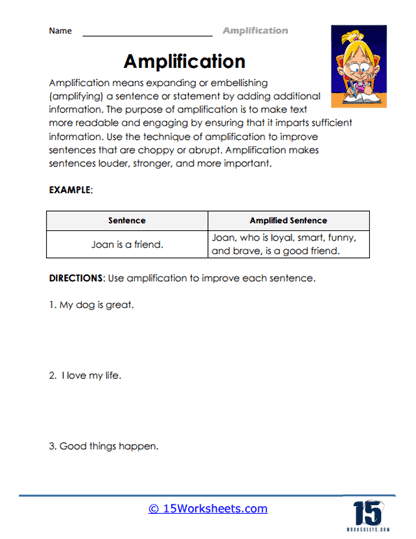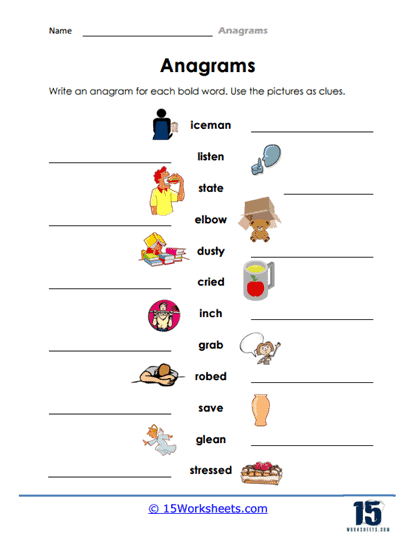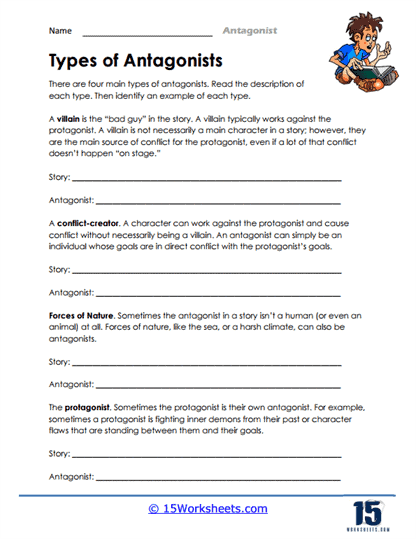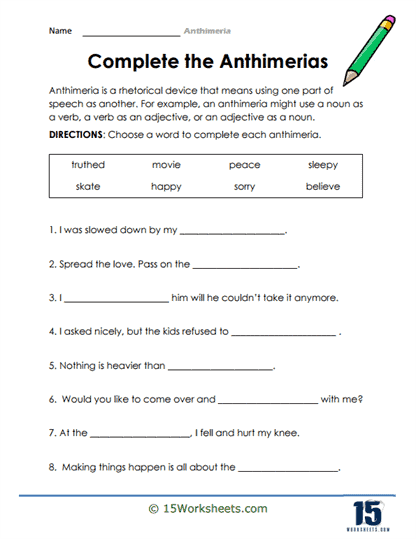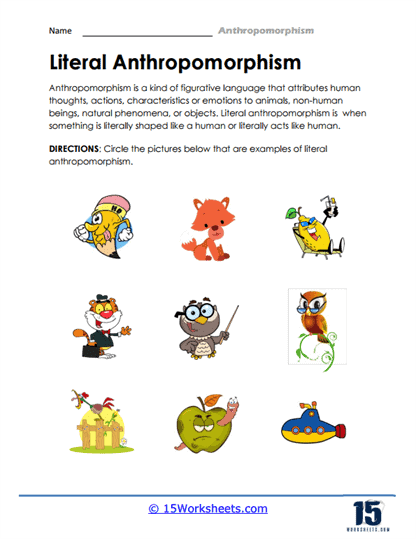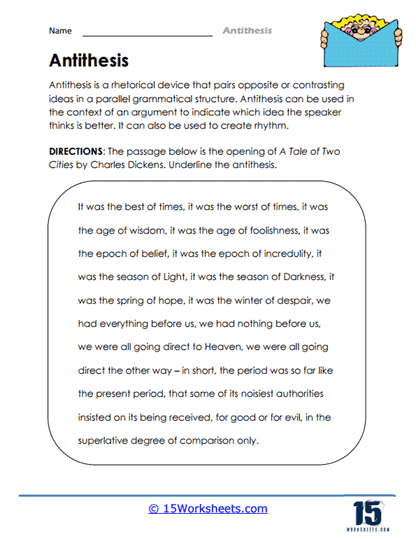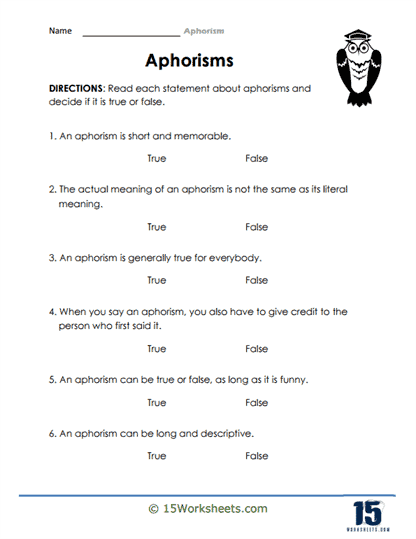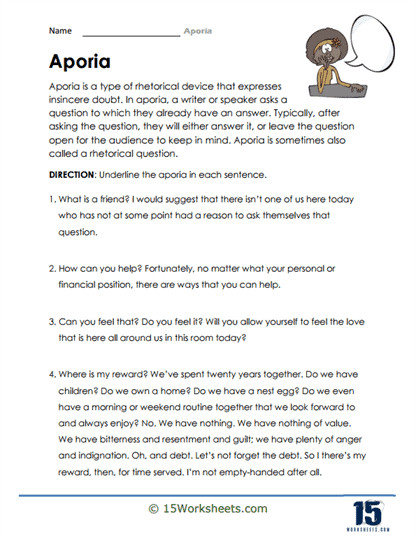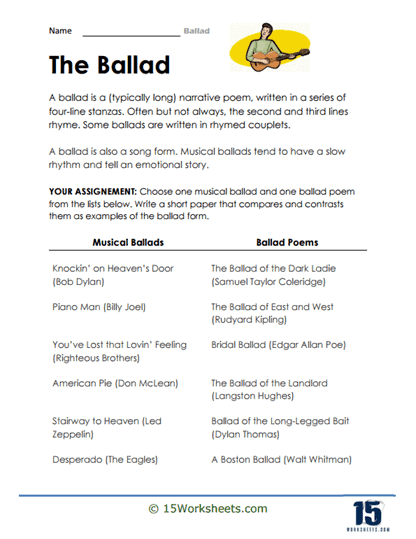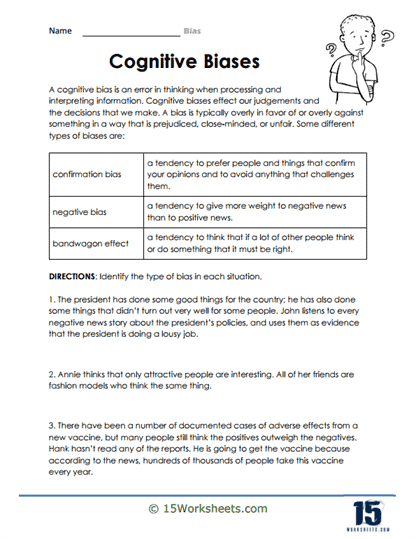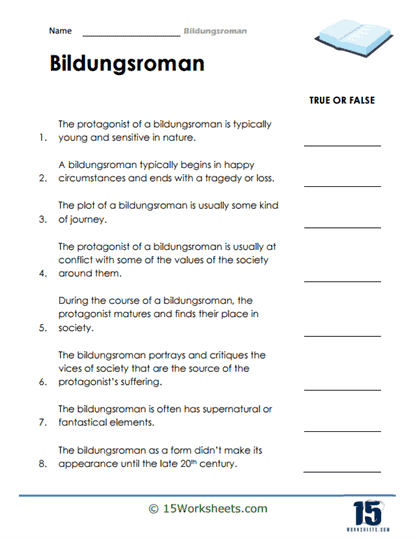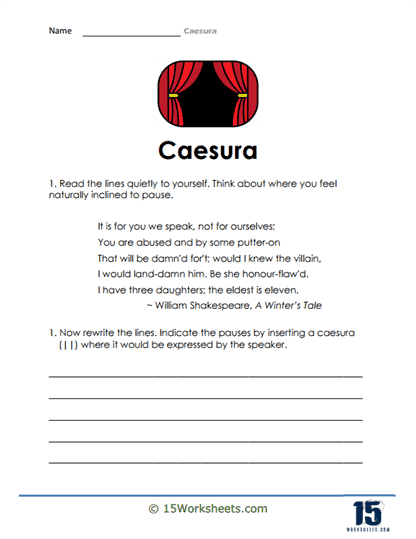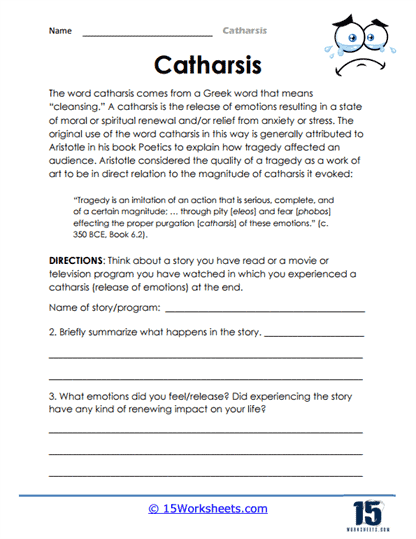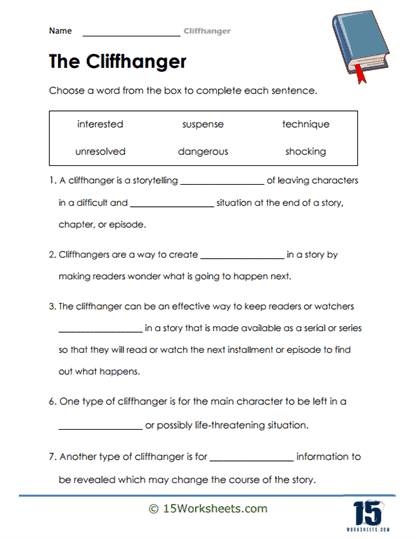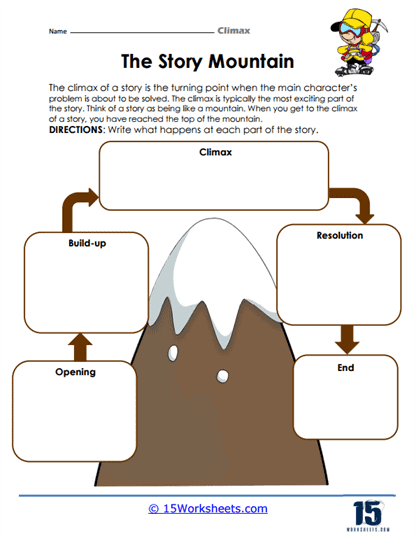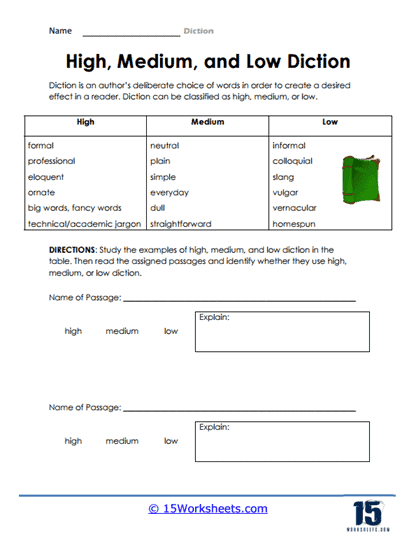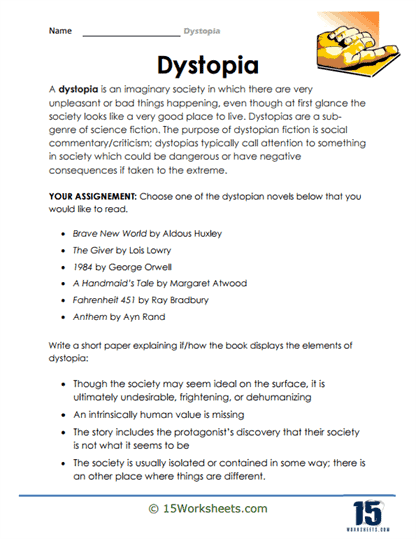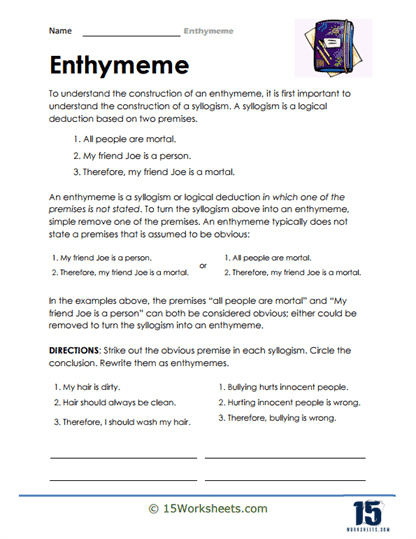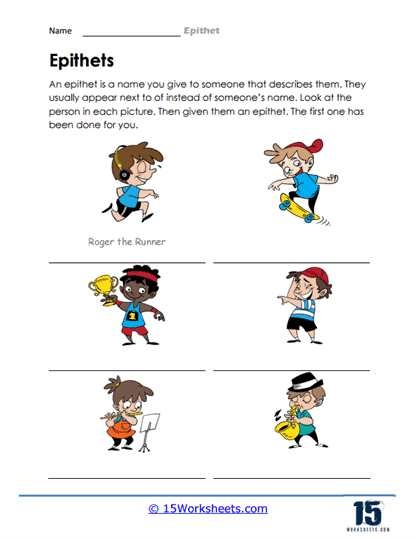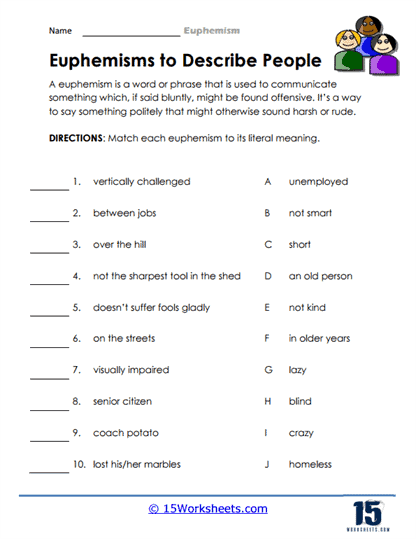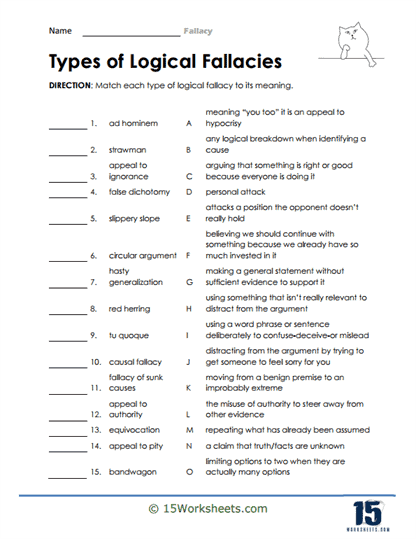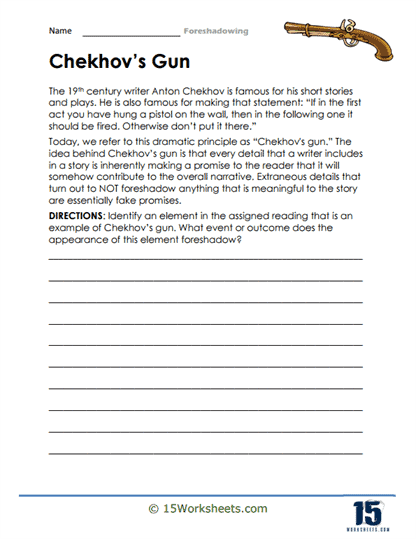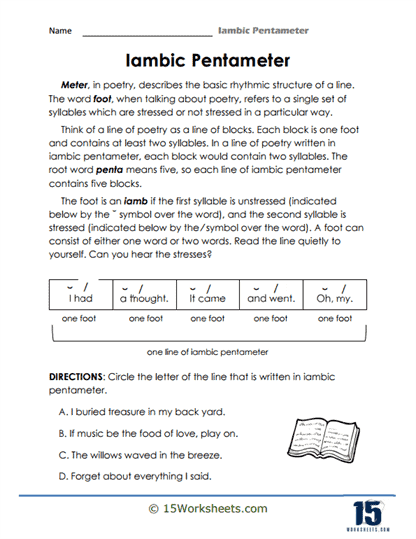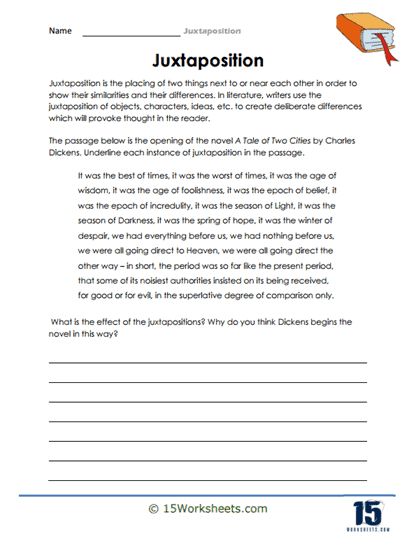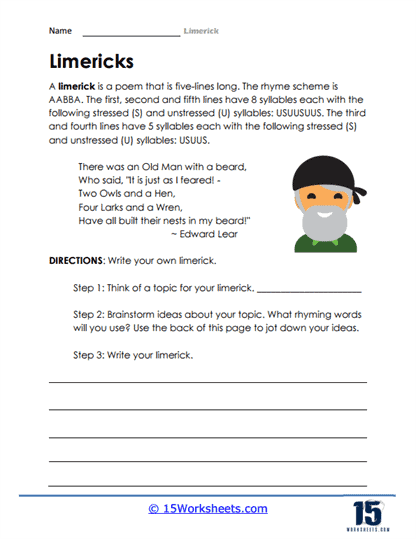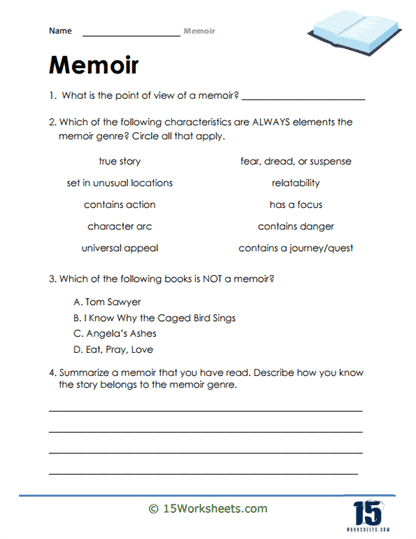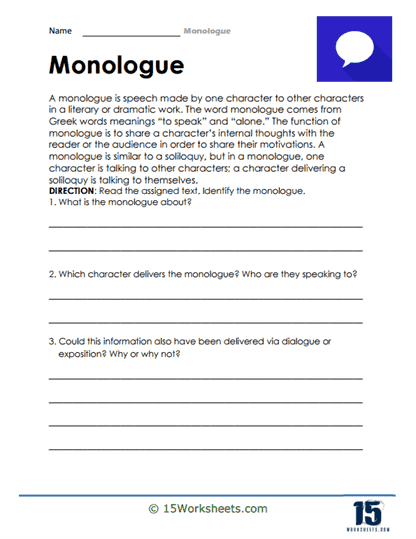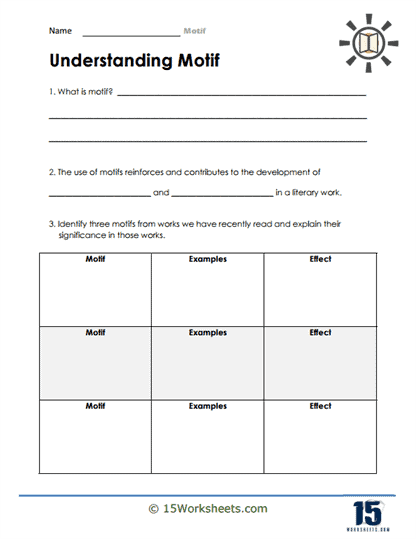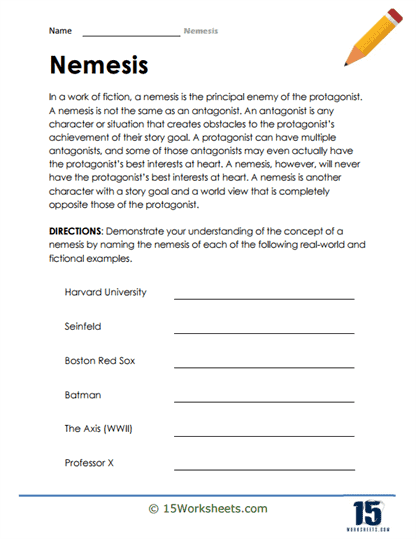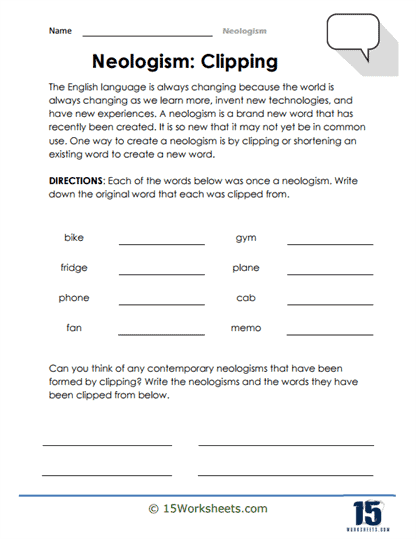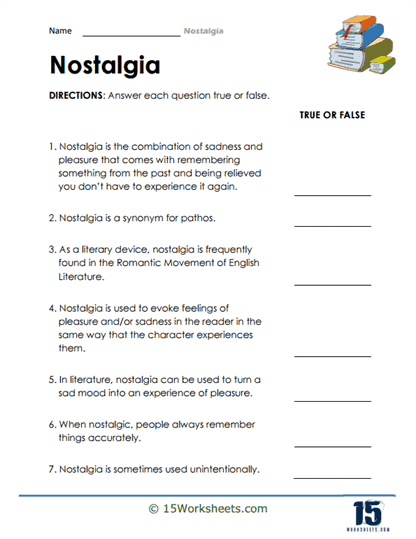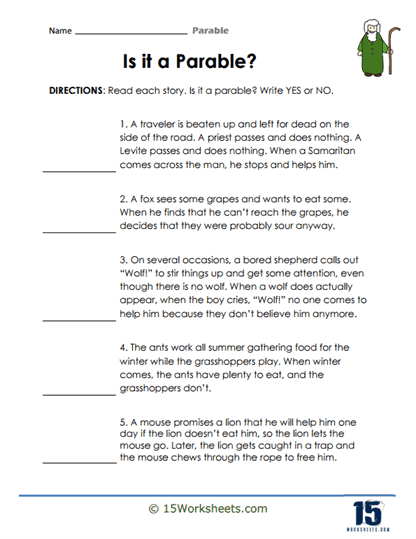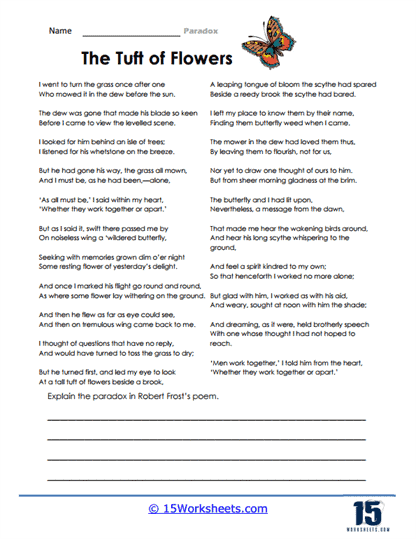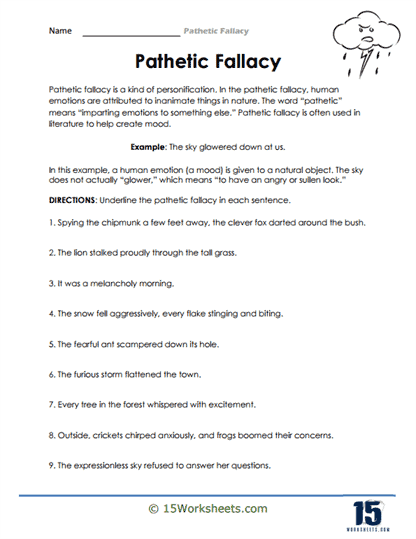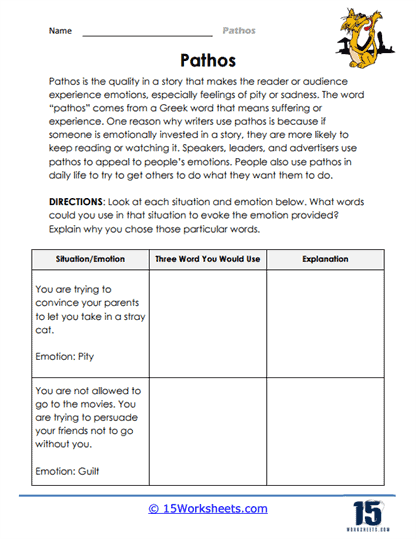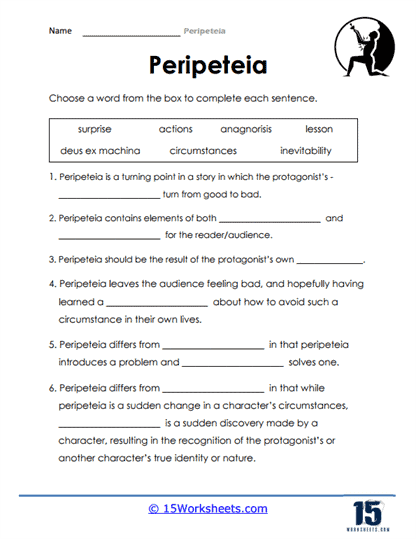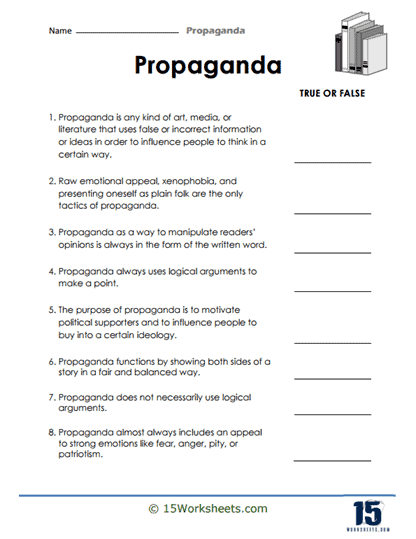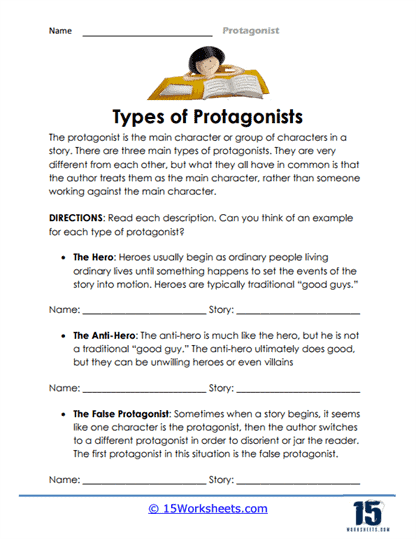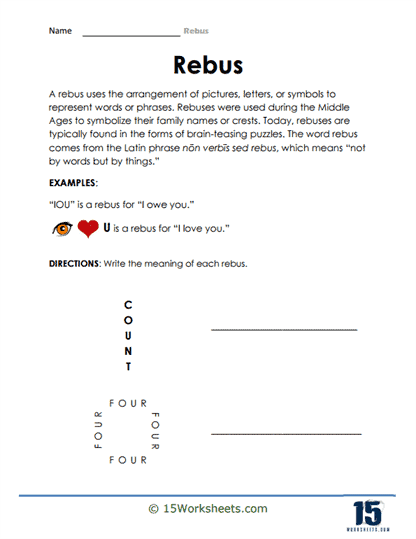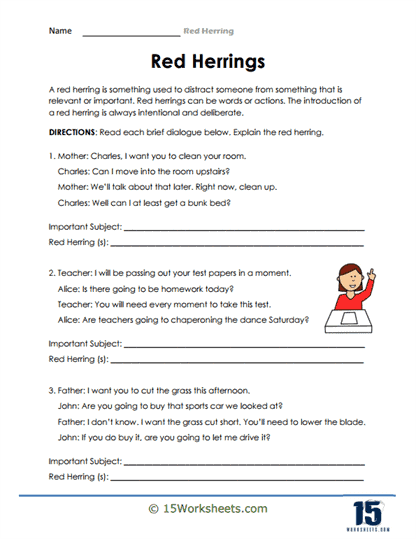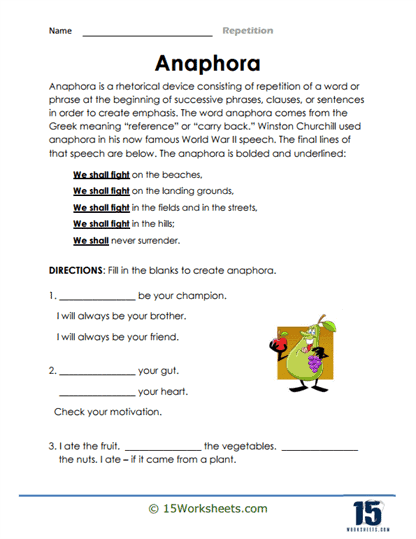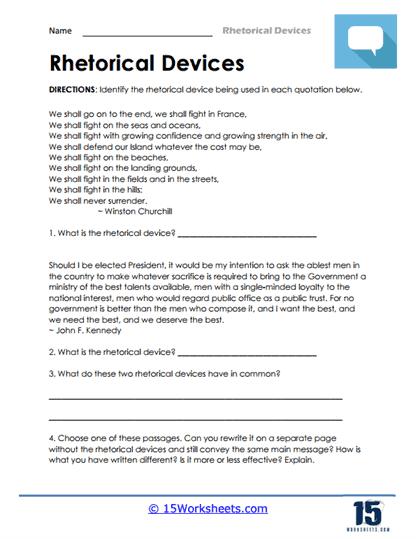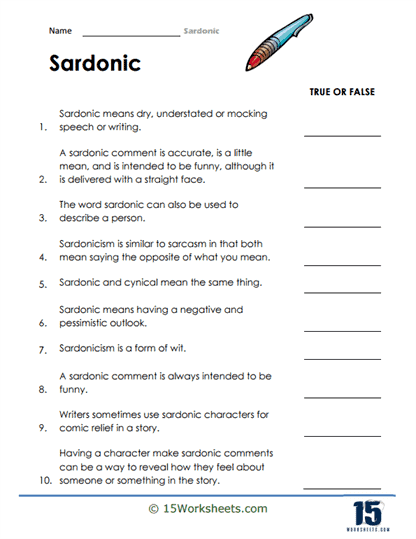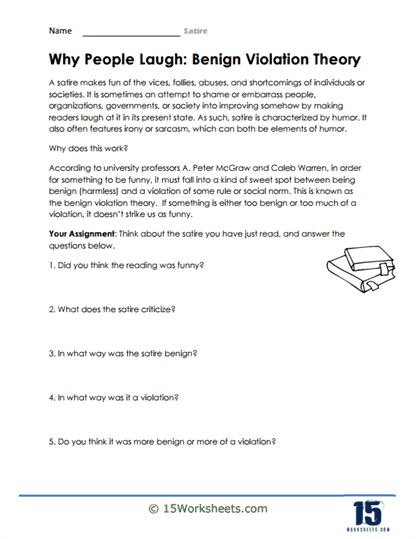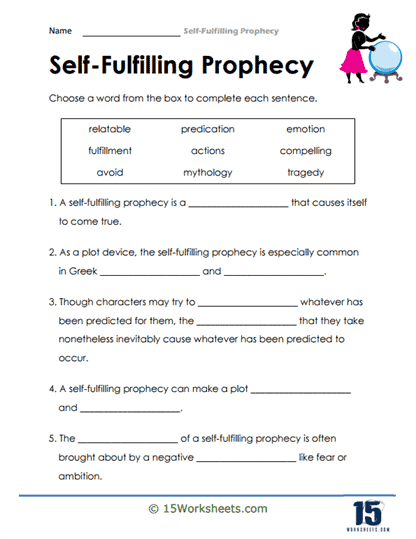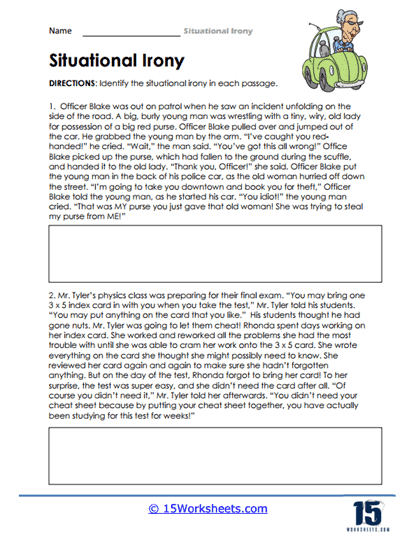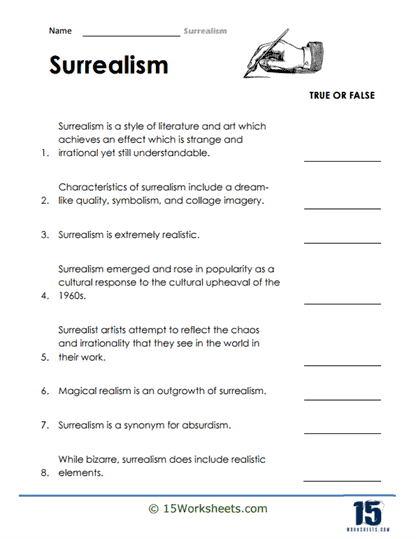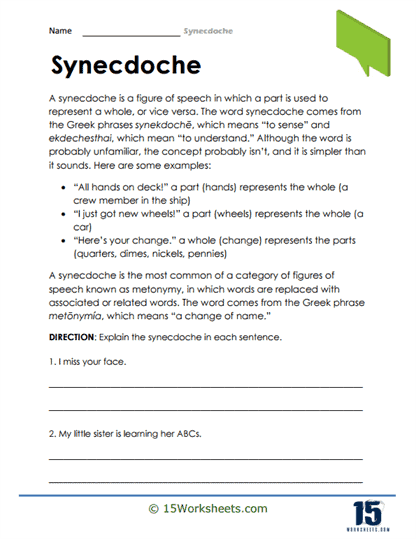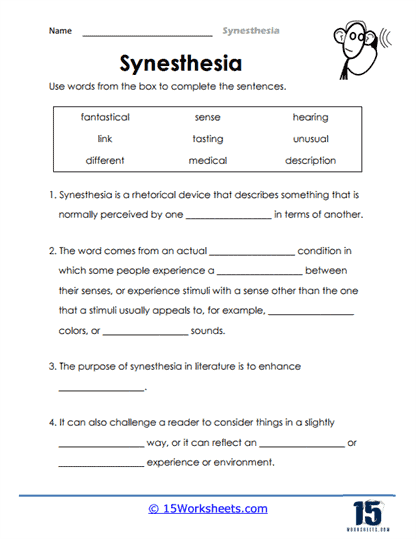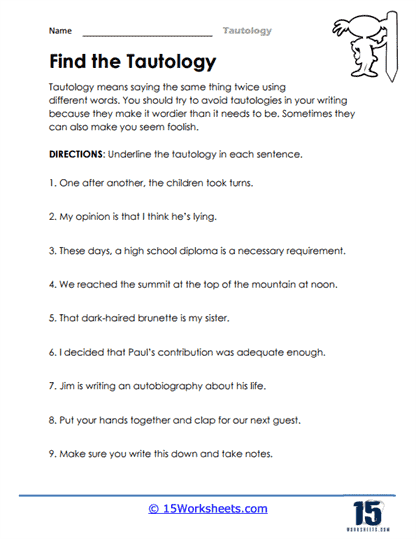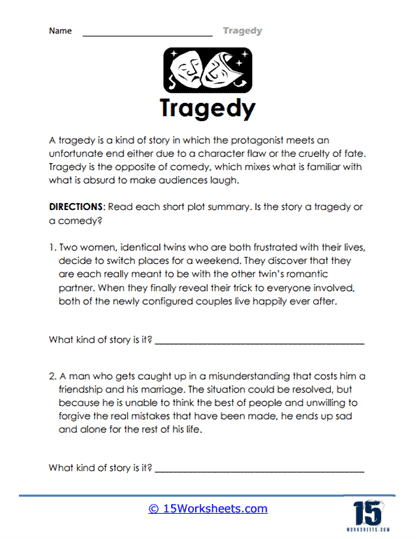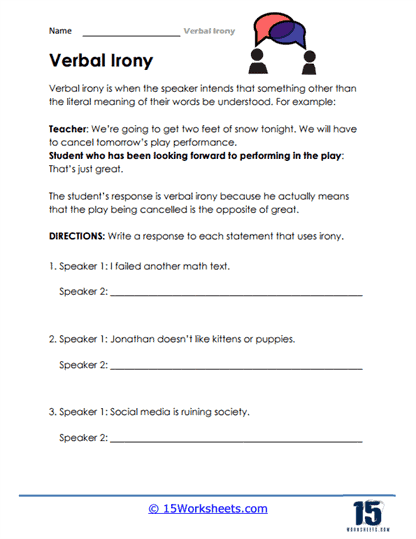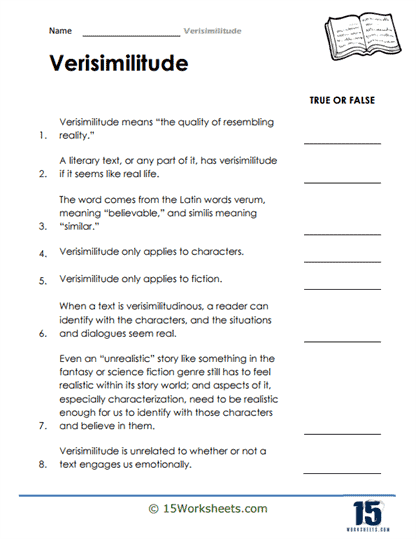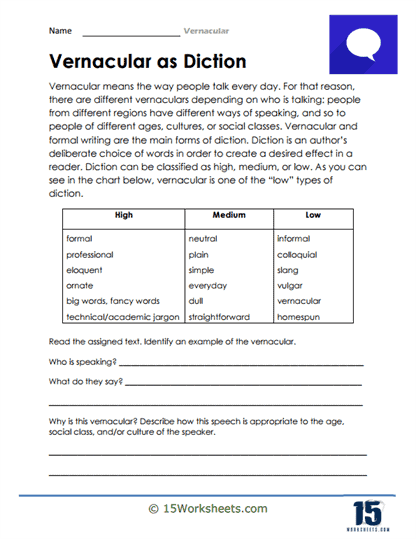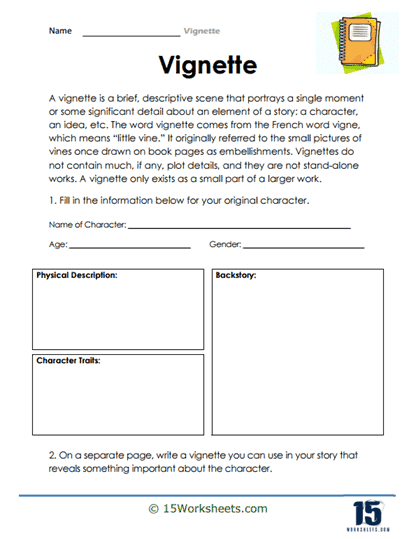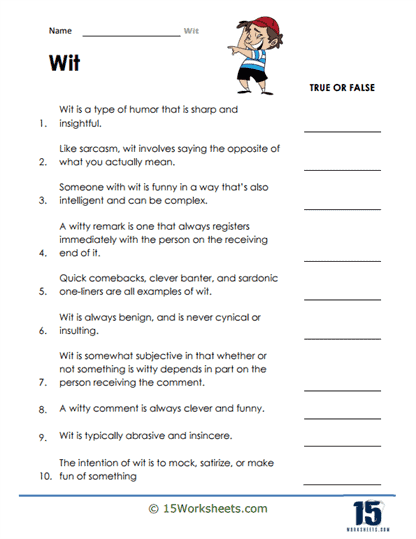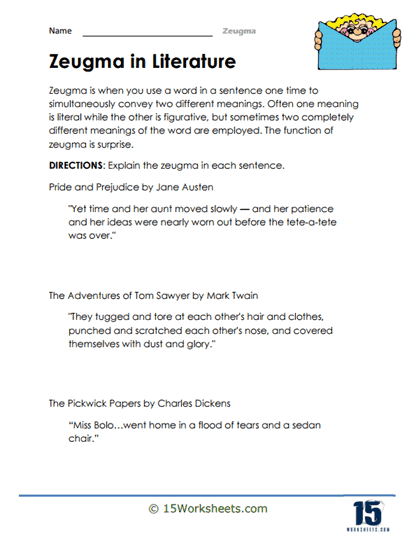Literary Devices Worksheets
About Our Literary Devices Worksheets
Learning about ad hominem helps students recognize and avoid fallacious arguments that attack a person’s character rather than addressing the issue at hand, promoting critical thinking and constructive debates. It also encourages students to engage in more respectful and reasoned discussions, both in academic settings and in daily life.
Understanding ambiguity in language and literature encourages students to engage with texts on a deeper level, as they learn to consider multiple interpretations, fostering analytical and creative thinking. It also prepares them to appreciate the richness and complexity of language, making them more effective readers and writers.
Studying amplification enhances students’ ability to use language for emphasis and persuasion, making them more effective communicators in both writing and speech. By recognizing amplification techniques in speeches, essays, and literature, students can analyze how writers and speakers use this device to convey ideas more powerfully.
Exploring anachronisms in literature and media helps students appreciate the importance of historical accuracy and contextual understanding, enriching their reading and viewing experiences. It also fosters a critical awareness of how historical inaccuracies can impact the credibility and authenticity of narratives.
Learning about anagrams not only enhances wordplay skills but also promotes linguistic creativity and problem-solving abilities. This can be a fun and engaging way for students to explore the flexibility of language and discover hidden meanings or connections within words and phrases.
Recognizing anaphora in speeches and literature aids students in analyzing the impact of repetition on rhetoric, improving their ability to identify persuasive techniques. It also encourages students to explore how this device can be used to create rhythm and emphasis in written and spoken expression.
Studying anecdotes in storytelling and argumentation helps students understand the power of personal experiences in making narratives relatable and persuasive. It teaches them to evaluate the relevance and effectiveness of anecdotes in various contexts, from literature to persuasive essays.
Analyzing antagonists in literature fosters empathy and a deeper understanding of complex characters, encouraging students to think critically about character motivations and development. It also allows students to explore the role of conflict and opposition in driving a story’s plot and themes.
Learning about anthimeria demonstrates the versatility of language and encourages students to experiment with creative word usage in their writing. It challenges students to think outside the conventional boundaries of language, leading to more imaginative and expressive communication.
Understanding anthropomorphism in literature and media helps students connect with and analyze characters or entities with human-like qualities, promoting empathy and critical analysis. It also allows students to explore the blurring of boundaries between human and non-human entities, opening discussions on ethics, identity, and symbolism.
Recognizing antithesis in rhetoric and literature sharpens students’ analytical skills by allowing them to explore contrasting ideas and themes within texts. It encourages them to delve deeper into the text’s meaning and consider how opposing elements create tension and meaning.
Studying aphorisms encourages students to distill wisdom and insight into concise, memorable phrases, improving their own communication and writing skills. It also exposes students to the power of brevity and the impact of timeless truths encapsulated in succinct statements.
Exploring aporia in literature and argumentation helps students appreciate the value of questioning and uncertainty in critical thinking and inquiry. It encourages them to grapple with complex issues and recognize that acknowledging uncertainty can be a crucial step in the pursuit of knowledge.
Learning about aposiopesis aids students in recognizing and interpreting abrupt or incomplete thoughts in speech and writing, enhancing their comprehension and analysis. It highlights the power of silence and implication in communication, prompting students to consider the unspoken in textual and spoken discourse.
Understanding archaisms in language and literature allows students to appreciate how language evolves over time, fostering historical and cultural awareness. It also encourages students to engage with older texts and documents in their original forms, promoting a deeper understanding of history and literature.
Analyzing archetypes in literature and media helps students recognize recurring character types and themes, deepening their understanding of storytelling conventions and cultural symbols. It also encourages critical thinking by prompting students to explore how archetypes evolve and adapt across different narratives.
Learning about asyndeton in writing and rhetoric allows students to appreciate the power of omitting conjunctions for emphasis and pacing. It encourages them to experiment with sentence structure and rhythm in their own writing, making their communication more dynamic and engaging.
Studying ballads in literature and music enhances students’ awareness of narrative storytelling through song. It encourages them to explore the connection between music and literature, fostering a greater appreciation for the fusion of artistic forms.
Exploring bathos in literature and humor helps students recognize and analyze shifts in tone, creating moments of unexpected humor or disappointment. It also encourages them to experiment with tone and emotional contrasts in their own writing to engage and surprise their readers.
Understanding bias in media and communication empowers students to critically evaluate information sources, fostering media literacy and the ability to discern between objective reporting and subjective opinions. It also encourages a more nuanced and open-minded approach to information consumption.
Analyzing bildungsroman novels helps students explore the themes of growth and self-discovery, fostering empathy and self-reflection. It encourages them to relate the protagonist’s journey to their own personal development.
Learning about cacophony in poetry and literature exposes students to the deliberate use of harsh or discordant sounds for thematic effect. It encourages them to analyze how sound and rhythm contribute to a text’s emotional impact.
Studying caesura in poetry and prose aids students in recognizing and appreciating the use of pauses and breaks for emphasis and pacing. It also encourages them to experiment with varied sentence structures and rhythms in their writing.
Exploring catharsis in literature and drama helps students understand the emotional release and purification that storytelling can offer. It encourages them to reflect on the power of narrative in addressing and processing complex emotions.
Chiasmus is a rhetorical device where words or phrases are repeated in reverse order to create a parallel structure, often used to emphasize contrast or to create a balanced and memorable statement.
Circumlocution is a literary device where a writer intentionally uses excessive language or unnecessarily complex expressions to convey a simple idea or concept, often to avoid being direct or to create a certain tone or atmosphere. It can serve to add depth to descriptions or characters’ speech patterns, but may also obscure clarity or straightforward communication.
Understanding cliffhangers in literature and media keeps students engaged with narratives and prompts them to speculate about potential outcomes. It encourages active reading/viewing and the development of analytical and prediction skills.
A collection of Climax worksheets for students is designed to deepen their understanding of narrative structure and storytelling. These worksheets provide exercises and activities that challenge students to identify, analyze, and create climactic moments in various forms of literature, from classic novels to contemporary short stories, helping them develop crucial skills in literary analysis and narrative composition.
Coherence in literature refers to the quality of a text where all its elements, such as plot, characters, themes, and style, work together seamlessly to create a unified and understandable whole. A coherent piece of writing ensures clarity, logic, and consistency, allowing readers to easily follow and comprehend the author’s intended message or story.
The denouement is the final resolution or outcome of a story, occurring after the climax and often tying up loose ends and providing closure to the plot. It allows for the unraveling of the story’s conflicts and reveals the ultimate fate of the characters, bringing the narrative to a satisfying conclusion.
Diacope is a literary device characterized by the repetition of a word or phrase with one or more words in between, often for emphasis or to create rhythm.
A collection of Diction worksheets for students aims to enhance their mastery of language precision and communication. These worksheets provide engaging exercises that prompt students to explore various aspects of word choice, from connotations and denotations to tone and mood, helping them sharpen their critical reading, writing, and analytical skills while fostering an appreciation for the power of words.
In literature, a dilemma is a situation in which a character faces a difficult choice between two equally undesirable options, often resulting in moral conflict or internal turmoil. These dilemmas are frequently used by authors to explore complex ethical or emotional themes and to challenge the characters’ values or beliefs.
Analyzing doppelgangers in literature and film allows students to delve into themes of identity, duality, and the human psyche. It encourages them to explore the complexities of character development and symbolism.
Learning about double entendres in language and humor sharpens students’ awareness of double meanings and wordplay. It encourages them to appreciate the subtleties and humor inherent in language use.
Studying dystopian literature and narratives prompts students to reflect on societal issues, ethics, and the consequences of unchecked power. It encourages critical thinking about the future and the role of individuals in shaping it.
An elegy is a poem or song that expresses sorrow or lamentation, typically for the deceased. It often reflects on themes of loss, grief, and mortality, and is characterized by a somber and reflective tone.
Enjambment is a literary device where a sentence or phrase continues from one line or stanza to the next without a pause or punctuation, creating a sense of flow and continuity in poetry. It often adds momentum or tension to the verse, allowing ideas to spill over and connect across lines.
Exploring enthymemes in argumentation helps students recognize and construct persuasive arguments with implicit premises. It encourages them to become more effective and nuanced communicators in debates and essays.
An epitaph is a short inscription or verse written on a tombstone or monument in memory of a deceased person. It typically summarizes the life or character of the individual and serves as a lasting tribute or remembrance.
An epithet is a descriptive word or phrase that is often used to characterize a person, place, or thing in literature. It serves to highlight specific qualities or traits, providing readers with a vivid impression of the subject being described.
Understanding euphemisms in language and communication teaches students the art of diplomacy and sensitivity in addressing difficult or sensitive topics. It encourages thoughtful and considerate communication.
Exemplum is a literary device where a story or anecdote is used to illustrate a moral or teach a lesson within a larger work. These examples are often drawn from history, mythology, or folklore, serving to clarify the author’s thematic message or argument.
Learning about fallacies in reasoning and argumentation equips students with the tools to identify and avoid flawed arguments, fostering critical thinking and logical analysis. It also encourages students to construct more valid and persuasive arguments.
Studying foreshadowing in literature allows students to appreciate how authors create suspense and build anticipation. It encourages them to analyze narrative techniques and predict future events in a story.
Exploring hubris in literature and mythology offers students insights into the dangers of excessive pride and overconfidence. It encourages them to reflect on the complexities of character flaws and their consequences.
Learning about iambic pentameter in poetry enhances students’ understanding of rhythm and meter in verse. It encourages them to explore the musicality of language and experiment with metrical patterns in their own writing.
Innuendo is a literary device involving subtle or indirect suggestions, insinuations, or implications, often with a negative or suggestive connotation. It allows writers to convey ideas or meanings without explicitly stating them, relying on the reader’s inference and interpretation.
Intertextuality refers to the relationship between different texts, where one text refers to, quotes, or alludes to another text, enriching the meaning and depth of both. It allows writers to engage with existing cultural or literary works, creating layers of meaning and connection that contribute to the richness of their own writing.
Intonation refers to the rise and fall of pitch in speech, often conveying emotions, attitudes, or meanings beyond the literal words spoken. It plays a crucial role in dialogue and narration, enhancing the expressiveness and subtlety of language in literature.
Invective is the use of harsh, abusive language or insults to express strong disapproval or contempt towards someone or something. It serves as a rhetorical tool to attack or denounce individuals, ideas, or institutions, often employed for dramatic effect or to incite emotional response.
Analyzing juxtaposition in literature and art helps students recognize the power of contrast in conveying meaning and emotion. It encourages them to explore the deliberate placement of elements for thematic and visual impact.
Studying limericks as a form of humorous poetry encourages students to engage with rhyme, rhythm, and wordplay. It fosters creativity and the appreciation of humor in literature.
Melodrama employs exaggerated emotions, simplified characterizations, and sensationalized plots to evoke strong emotional responses from the audience. It often features clear distinctions between good and evil, heightened conflicts, and dramatic resolutions aimed at eliciting intense feelings such as sympathy, fear, or excitement.
Exploring memoirs allows students to connect with personal narratives and diverse perspectives. It encourages empathy, self-reflection, and an understanding of the power of storytelling to convey lived experiences.
Metonymy substitutes the name of one thing with the name of something else closely associated with it, typically to enhance imagery or convey a related concept indirectly.
Learning about monologues in drama and literature helps students analyze character development and internal conflicts. It encourages them to explore the depth of characters’ thoughts and emotions.
Studying motifs in literature and art promotes an understanding of recurring symbols and themes. It encourages students to delve into the layers of meaning and symbolism within a text or visual work.
Nemesis represents the inevitable consequence or antagonist that opposes and punishes the protagonist’s actions or hubris in literature, serving as a force of retribution or justice. It embodies the idea of poetic justice, ensuring that characters face the repercussions of their deeds.
Neologism refers to the creation or adoption of new words or expressions, often to address emerging concepts or changes in society, language, or technology. Authors employ neologisms to enrich their writing with fresh, inventive language that reflects contemporary trends or imaginative worlds.
Non sequitur involves a statement or conclusion that does not logically follow from the previous argument or context, often leading to confusion or absurdity. It disrupts the coherence of the narrative or conversation, creating a jarring effect for the audience
Nostalgia is a sentiment or longing for the past, typically evoked by fond memories or a yearning for a time perceived as simpler or happier. In literature, it serves to imbue the narrative with emotional depth, inviting readers to reflect on personal or collective history.
Analyzing parables in religious and moral storytelling encourages students to reflect on moral and ethical lessons. It fosters critical thinking about the application of allegorical narratives to real-life situations.
Learning about paradoxes in philosophy and literature challenges students to grapple with contradictions and explore the complexities of truth and reality. It encourages them to think critically about the nature of paradoxical statements.
Studying parody in literature and humor allows students to appreciate the art of satire and imitation. It encourages them to analyze the techniques used to mock or comment on a specific genre or work.
Pathetic fallacy attributes human emotions or traits to inanimate objects or nature, often mirroring or reflecting the characters’ emotional states or the narrative’s mood. By imbuing the environment with human-like qualities, it enhances the atmosphere and symbolism within the text, deepening the reader’s understanding and emotional engagement.
Pathos is the rhetorical appeal to the audience’s emotions, aiming to evoke feelings such as pity, sympathy, or compassion. It serves to elicit a powerful emotional response, often used to persuade or influence the audience’s attitudes or actions.
Peripeteia refers to a sudden reversal of fortune or circumstance experienced by a character, typically from a position of success to one of misfortune or vice versa. It serves to introduce dramatic tension and unexpected plot twists, often leading to a profound shift in the narrative’s direction.
Pleonasm involves the use of unnecessary or redundant words or phrases that convey the same meaning, often for emphasis or rhetorical effect. It can serve to reinforce a point or add intensity to language, although it risks appearing verbose or superfluous.
Polyptoton involves the repetition of words derived from the same root but with different grammatical forms or tenses within the same sentence or phrase. This technique adds emphasis, rhythm, and complexity to the text, enhancing its poetic or rhetorical impact.
Polysyndeton is the repetitive use of conjunctions (such as “and,” “or,” or “but”) in close succession within a sentence or phrase, creating a sense of accumulation, urgency, or emphasis. By linking phrases or clauses more closely together, it can convey a sense of continuity, intensity, or overwhelming abundance in the narrative.
A portmanteau blends the sounds and meanings of two or more words to create a new word that encapsulates aspects of each original term. This linguistic technique often arises to efficiently express complex ideas or to coin terms for novel concepts.
Exploring prologues in literature helps students understand the role of introductory material in setting the stage for a story. It encourages them to evaluate the effectiveness of prologues in engaging readers.
Learning about propaganda in media and politics empowers students to critically assess persuasive techniques and biases in information dissemination. It encourages media literacy and informed citizenship.
The protagonist is the central character in a story, often driving the narrative forward and facing the main conflicts or challenges. Typically, readers or viewers identify with the protagonist’s journey and perspective, experiencing the story through their eyes.
Studying rebuses as puzzles and word games enhances students’ problem-solving and creative thinking skills. It encourages them to play with language and visual representation.
Analyzing red herrings in literature and argumentation teaches students to identify and avoid distractions from the main issue or argument. It encourages them to stay focused and critical in their analysis.
Repetition involves the deliberate reuse of words, phrases, or structures for emphasis, rhythm, or to reinforce a particular idea or theme within a text. By echoing elements throughout a work, repetition can create a sense of pattern, unity, and resonance, enhancing the impact of the writing on the reader.
Learning about rhetorical devices in persuasion and communication equips students with tools for effective rhetoric and argumentation. It encourages them to recognize and employ these devices in their own writing and speaking.
Exploring sarcasm in language and humor helps students differentiate between literal and figurative language. It encourages them to appreciate the subtleties and irony in sarcastic communication.
Sardonic describes a form of mocking or cynical humor, often characterized by bitterness or scornful sarcasm. It conveys a sharp, cutting wit that is tinged with disdain or mockery towards its subject.
Studying satire in literature and humor allows students to recognize and analyze social commentary and criticism through humor. It encourages critical thinking about societal issues and the power of satire to provoke change.
Self-fulfillment occurs when a character’s beliefs or actions lead to the realization of their own expectations or prophecies, often unintentionally. This literary device underscores themes of fate, destiny, and the consequences of one’s choices within the narrative.
Analyzing situational irony in literature and storytelling helps students understand the unexpected twists and turns that narratives can take. It encourages them to engage with the unpredictable elements of storytelling.
A soliloquy is a speech delivered by a character alone on stage, revealing their inner thoughts, feelings, or intentions to the audience. It provides insight into the character’s psyche and serves as a dramatic device for exposition or reflection.
Learning about surrealism in art and literature encourages students to explore the boundaries of reality and imagination. It fosters creativity and the appreciation of unconventional and dreamlike aesthetics.
Studying synecdoche in language and literature deepens students’ understanding of the relationship between parts and wholes. It encourages them to recognize how synecdoche is used to convey complex ideas through concise language.
Synesthesia refers to a literary technique where one sensory experience is described in terms of another, blending different senses to create a vivid and imaginative portrayal of an experience or object. By intertwining sensory perceptions, it enhances the descriptive power of language, offering readers a multi-dimensional understanding of the subject.
Tautology involves the redundant repetition of words or ideas, stating the same thing twice in different words. It serves little purpose beyond emphasizing a point or adding rhetorical flourish, often diminishing the clarity or impact of the expression.
Exploring tragedy in literature and drama allows students to empathize with the human experience of suffering and loss. It encourages them to reflect on the complexities of human nature and fate.
A trope is a commonly used theme, motif, or convention in literature or storytelling, often recognizable to the audience due to its repeated occurrence across various works. It provides a familiar framework for narratives, allowing writers to convey ideas, evoke emotions, or engage with cultural concepts in a recognizable and effective manner.
A truism is a statement that is self-evident or universally accepted as true, often lacking in originality or depth. While it may convey an undeniable truth, it tends to be overly simplistic and lacks nuance or complexity, offering little insight beyond common knowledge.
Understatement involves intentionally downplaying the significance or severity of something, usually to create a humorous or ironic effect or to emphasize the gravity of a situation indirectly. By minimizing the importance or impact of an event or statement, understatement often prompts the audience to consider the true depth or implications underlying the narrative.
Learning about utopia in literature and philosophy prompts students to envision and critique ideal societies. It encourages them to think critically about social and political systems and consider alternative possibilities.
Studying verbal irony in language and literature enhances students’ awareness of the contrast between words and intended meaning. It encourages them to analyze how irony contributes to humor and rhetorical effectiveness.
Verisimilitude refers to the degree to which a narrative or portrayal of events resembles reality or truth, enhancing its believability and authenticity. By incorporating realistic details, settings, and characters, verisimilitude enables readers to immerse themselves more deeply in the story and engage with its themes and messages.
Vernacular refers to the everyday language spoken by a particular group or community, often characterized by regional dialects, slang, and colloquialisms. In literature, the use of vernacular can add authenticity and richness to dialogue, capturing the nuances of cultural identity and social dynamics.
A vignette is a brief, descriptive scene or episode within a larger narrative, typically focusing on a single character, moment, or theme. It allows for a concentrated exploration of emotion, atmosphere, or symbolism, offering snapshots that contribute to the overall texture and depth of the work.
Wit is a literary device characterized by cleverness, humor, and wordplay, often employed to entertain or provoke thought. It involves quick and intelligent use of language to create amusing or insightful observations, adding levity or depth to a narrative or dialogue.
Zeugma involves using a single word to modify or govern two or more words, typically with each word in a different sense or context. This creates a compact yet impactful expression that relies on the clever manipulation of language to convey multiple meanings simultaneously.



